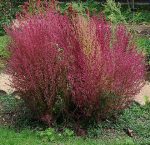 Also known as summer cypress, this this half-hardy annual often grown as a shrub is native to central and southern Europe and Asia and was introduced into the US in the mid to late 1800s as an ornamental but has become weedy or invasive in some areas. It is a member of the amaranth family, Amaranthaceae, that also includes beet, celosia, and Russian thistle. The plants have a deep taproot, red-tinged stem, and narrowly ovate leaves that are up to 2″ long and have 1-5 prominent veins and entire margins fringed with hairs. The leaves are pale green in the summer and turn bright red in the fall, giving rise to the common name burning bush. In summer, inconspicuous flowers are carried in axillary or terminal spikes and consist of reproductive structures and green leaf-like bracts surrounded by tufts of hair. When the plants die they break off from the base and become tumbleweed. Plants are tolerant of heat, drought, and salt and are a good choice for a hedge, parterre edger, groundcover, erosion control, seaside garden, or as an accent plant. The genus name, Kochia, honors Wilhelm Daniel Josef Koch (1771-1849) professor of boany at Erlangen, Germany. The specific epithet, scoparia, is the Latin word meaning broom-like and refers to the use of the plant as a broom. The varietal name, tricophylla, comes from the Greek words trix meaning thread, and phylla meaning leaf.
Also known as summer cypress, this this half-hardy annual often grown as a shrub is native to central and southern Europe and Asia and was introduced into the US in the mid to late 1800s as an ornamental but has become weedy or invasive in some areas. It is a member of the amaranth family, Amaranthaceae, that also includes beet, celosia, and Russian thistle. The plants have a deep taproot, red-tinged stem, and narrowly ovate leaves that are up to 2″ long and have 1-5 prominent veins and entire margins fringed with hairs. The leaves are pale green in the summer and turn bright red in the fall, giving rise to the common name burning bush. In summer, inconspicuous flowers are carried in axillary or terminal spikes and consist of reproductive structures and green leaf-like bracts surrounded by tufts of hair. When the plants die they break off from the base and become tumbleweed. Plants are tolerant of heat, drought, and salt and are a good choice for a hedge, parterre edger, groundcover, erosion control, seaside garden, or as an accent plant. The genus name, Kochia, honors Wilhelm Daniel Josef Koch (1771-1849) professor of boany at Erlangen, Germany. The specific epithet, scoparia, is the Latin word meaning broom-like and refers to the use of the plant as a broom. The varietal name, tricophylla, comes from the Greek words trix meaning thread, and phylla meaning leaf.
Type: Annual used as a shrub
Outstanding Characteristic: Fall foliage
Form: Oval
Growth Rate: Rapid
Size: 2-3′ H x 1-1.5′ W
Light: Full sun
Soil: Average, dry, well-drained
Hardiness: Not hardy
Care: Low maintenance
Pests and Diseases: None of significance
Propagation: Seed (need light for germination); seedlings do not transplant well.
Outstanding Selection: ‘Childsii’
Photo Credit: Moonik Wikipedia